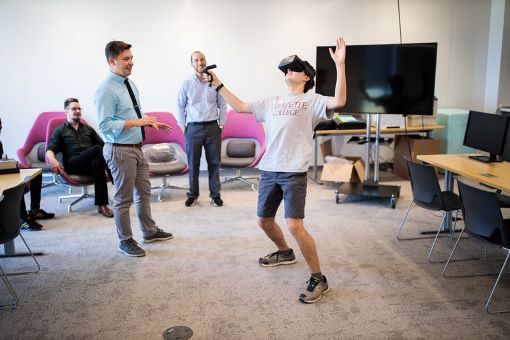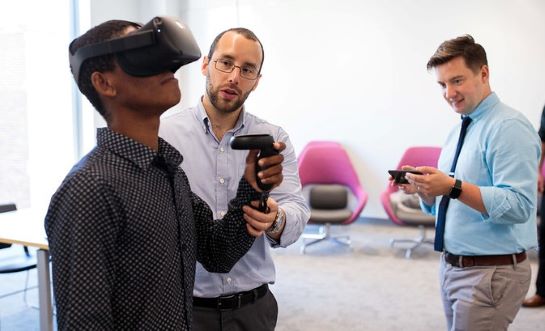Prof. Christian Lopez sees interdisciplinary benefits of immersive technology
By Bryan Hay
Imagine sipping coffee at Skillman Café, and, in an instant, you’re transported to Uffizi Gallery in Florence, the deepest part of the seas, back in time to see the rise of the Great Pyramids of Giza, or onto the floor of a manufacturing facility to test a new assembly process.
With virtual reality (VR) becoming more affordable and sophisticated, Christian Lopez, assistant professor of computer science, sees limitless possibilities for the technology to enhance students’ learning and engagement and apply it in the arts, humanities, sciences, and engineering.
Lopez was one of the authors of “Reinforcement Learning Content Generation for Virtual Reality Applications,” which was supported by the National Science Foundation. It also received the Virtual Environments & Systems committee’s best paper award at the American Society of Mechanical Engineers’ Computer Information & Engineering Conference in August. In it, he and his colleagues present a method to leverage machine learning to generate new VR content in ways that could help mitigate “novelty effects” and thereby keep students engaged.
The project’s main objective is to develop VR applications to teach industrial engineering concepts, and this work focused on leveraging machine learning to make them more engaging.
“Students may be engaged the first few days, but the next week if we continue showing them the same things, they could get disengaged as the novelty wears off,” he says. “The paper discusses how to use algorithms to automatically generate new content and new VR environments to transport them into different manufacturing environments.”

(L-R) Profs. Daniel Strömbom, Eric Hupe, and Christian Lopez bring virtual reality to Zachary Fiske ’23.
New to campus, Lopez already has started a community of practice with Eric Hupe, assistant professor of art, and Daniel Strömbom, assistant professor of biology, to explore the interdisciplinary and pedagogical possibilities of VR at Lafayette.
“Students from a wide variety of disciplines can greatly benefit from the immersive and interactive experience that the latest VR technology allows,” he says. “With this type of technology, a Lafayette student can be anywhere in the world. Moreover, students can get involved in the development of VR applications and gain valuable programming and problem-solving skills.”
Using CAD models, an environment can be transformed into a three-dimensional universe with VR. “You can get color and texture of walls and use algorithms to improve the resolution,” he says.
Lopez and his colleagues have created a VR application that simulates a drill manufacturing facility, where material-handling equipment and machinery can be manipulated to control production. This type of application can help students understand the complexities of production systems. He even imagines a program that would offer a virtual gallery of all of Lafayette’s artworks.
“When you put on a headset, you can easily forget that you’re in a cubicle and really believe you are in the VR environment,” he says.

Don Bosco Haingura ’23 experiences VR
“There’s even an application that will take you to the outside of the solar system,” he adds. “And as you float in space you can touch and manipulate the planets. VR not only simulates an environment that already exists but can go beyond that and create new environments with more interactions than is possible in real life.”
Strapping on a VR headset has its benefits, opening pathways for students to make and learn from mistakes without any lasting consequences and to explore the existing world and the virtual world.
“VR allows us to see the world in new ways,” Lopez says. “It’s one thing to visit a museum, but it’s something altogether transformational to go back in time to see a village in France during the Renaissance or see the creation of a volcanic mountain right before you.”

